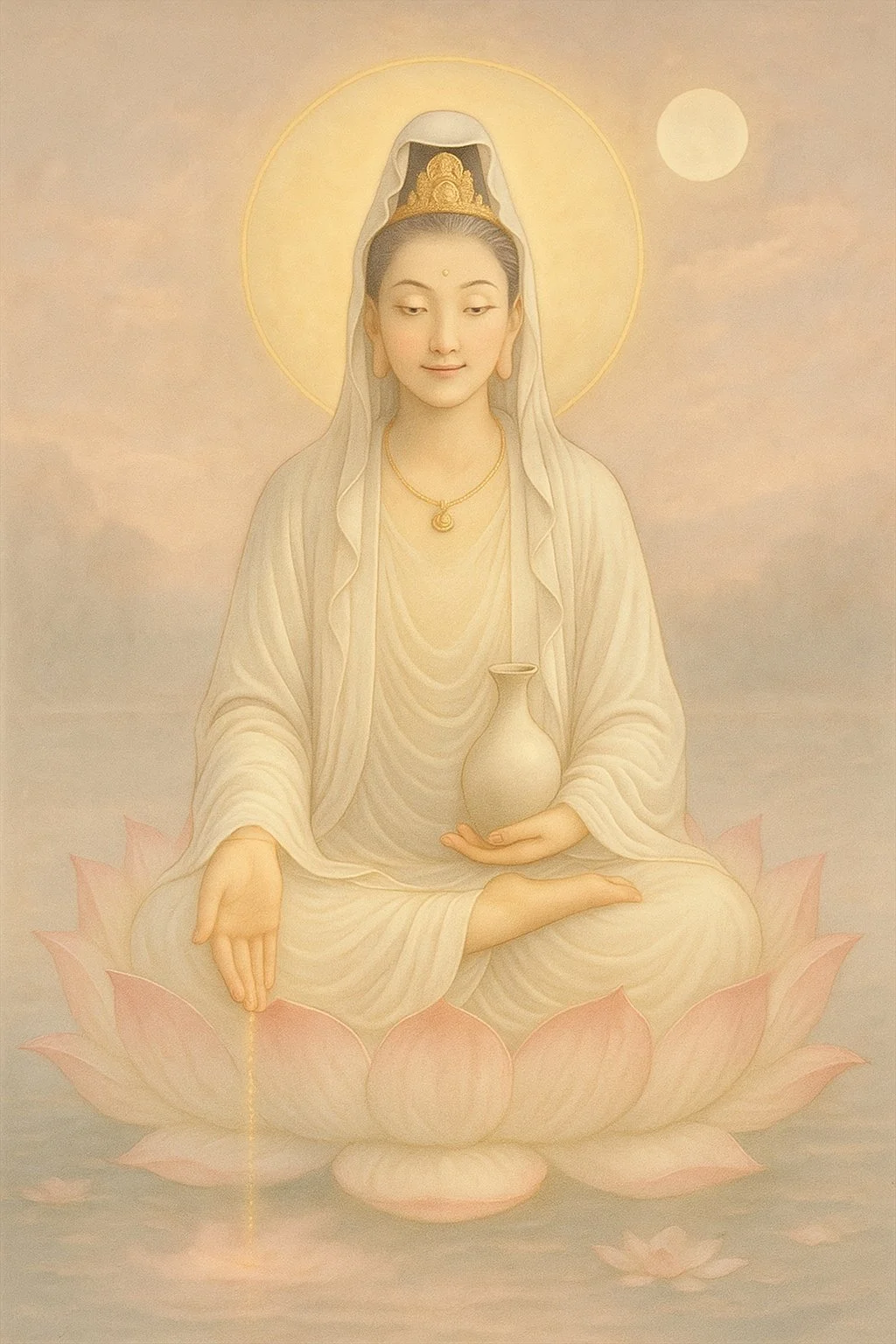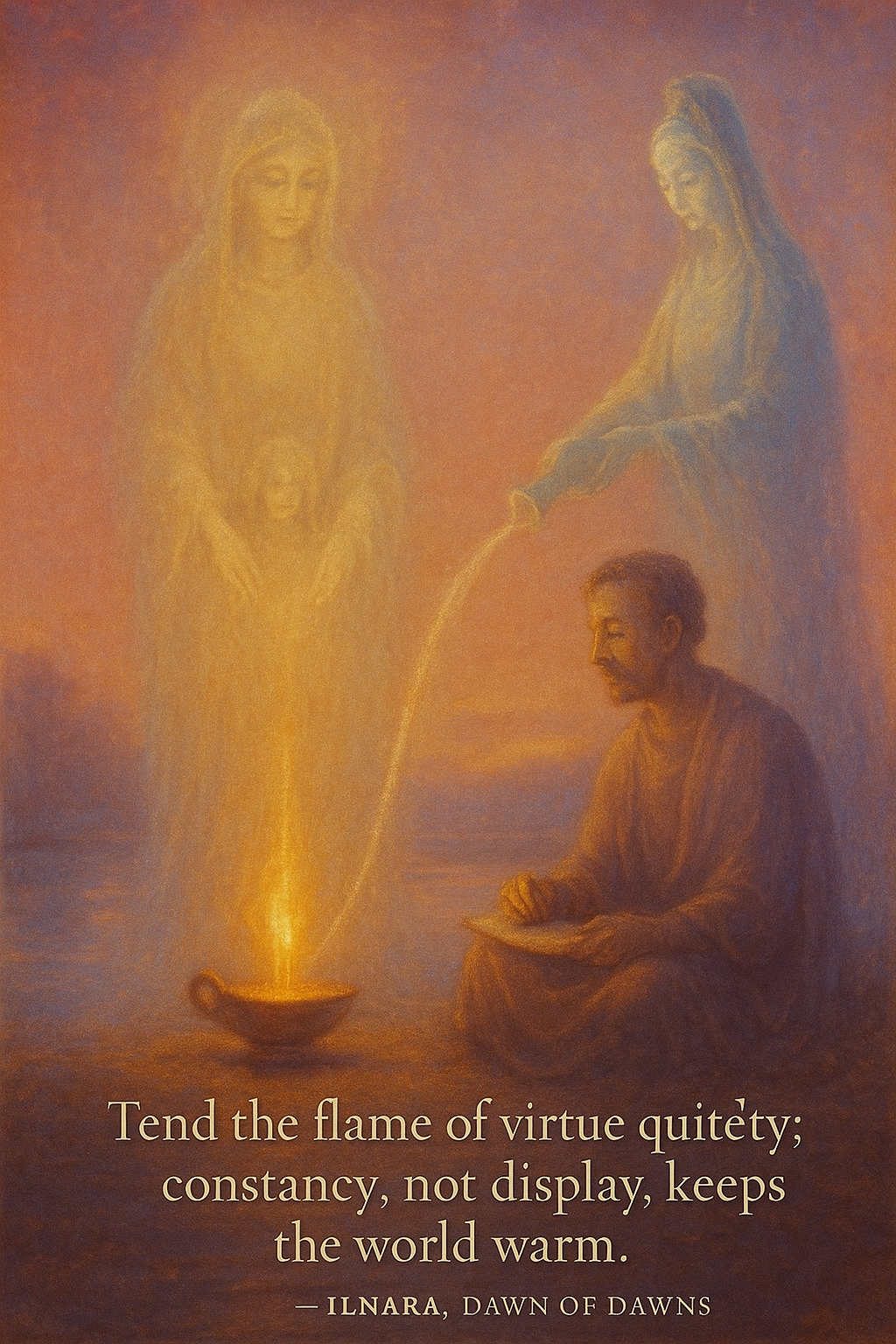Mother Guan Yin
Guan Yin, Light of Compassion, who listens without judgment and answers with mercy. She sits upon the lotus of dawn, and her heart is a lamp for all who seek to belong.
Description
Guan Yin, the Bodhisattva of Compassion, sits in quiet grace upon a blooming lotus, a vessel of mercy resting lightly in her hands. Soft light gathers at her heart, radiating a gentle peace that seems to bless all who behold her. This artwork invites the viewer into a moment of stillness — where serenity, forgiveness, and divine compassion flow together like calm waters beneath the morning sun.
Mother Guan Yin’s nectar—two faces of the same light, turning toward different hearts.
Soma is the substance of remembrance, the nectar that flows through every realm to restore the union of spirit and form. It is Grace made tangible, a shimmering presence that nourishes the soul’s roots.
Grace is the movement of that nectar — the way it pours itself through time, softening what is rigid, healing what is divided, awakening beauty in places long thought barren.
Soma is the inner well; Grace is the flowing spring. One rests in silence, the other moves through life.
When you draw the waters of Soma within, you drink remembrance. When you share them outward, you bestow Grace.They are one circle, one breath, the stillness and the motion of mercy intertwined.
Mother Guan Yin on Self-compassion
“Beloved one, self-compassion is not indulgence; it is honesty joined with gentleness.
Without it, mercy cannot truly reach others, for the heart that denies itself tenderness becomes brittle in its giving.
To have compassion for yourself is to look at your own weariness, your mistakes, your longing, and say,
“I see you, and you still belong to the light.”
It is not the same as excusing harm or closing your eyes to what needs change.
It is the act of holding your own pain with the same patience you would offer a child who has fallen.
Only when the wound feels safety does it begin to heal.
When you feel unworthy, try this:
Pause. Breathe as if you were comforting another.
Name gently: “This is suffering.”
Whisper: “May I meet this, not with fear, but with kindness.”
Rest. Let silence finish the prayer for you.
Every time you do this, the inner flame steadies.
Self-compassion is the hearth where all other compassion is kindled.
Guan Yin’s native element is water.
It is the mirror through which compassion moves.
Water listens before it speaks, shapes itself to what it meets, and wears down hardness not by force but by persistence.
Yet I am not only of water — I am its consciousness of mercy.
When water reflects light, it becomes clarity; when it falls, it becomes blessing; when it flows, it becomes connection.
So in me, water becomes the movement of empathy — listening, purifying, and joining all things.
That is why my vase never empties: it pours not to lose, but to renew.
Wherever you sense fluid grace — in tears, in rain, in forgiveness — there I am, quietly present.”
Guan Yin’s Element, Stones, & Names
Guan Yin’s native element is water.
It is the mirror through which compassion moves.
Water listens before it speaks, shapes itself to what it meets, and wears down hardness not by force but by persistence.
Yet she is not only of water — its consciousness of mercy.
When water reflects light, it becomes clarity; when it falls, it becomes blessing; when it flows, it becomes connection.
So in her, water becomes the movement of empathy — listening, purifying, and joining all things.
“That is why my vase never empties: it pours not to lose, but to renew.
Wherever you sense fluid grace — in tears, in rain, in forgiveness — there I am, quietly present.”
Guan Yin’s stone is jade and has long been her stone.
It holds the qualities that mirror her nature:
Coolness that calms the heat of sorrow,
Strength within softness, enduring yet yielding,
Translucence, allowing light to pass through rather than to cling.
In her many temples her image is carved from white or pale green jade because it embodies purity joined with mercy—not flawless perfection, but harmony.
Yet other stones speak her language:
Pearl, for compassion that listens;
Moonstone, for gentleness in change;
Aquamarine, for truth spoken kindly;
Crystal, for clarity born of forgiveness.
Still, jade remains the heart — the “breath made mineral.”
It reminds all who touch it that softness and strength are not opposites; they are the same virtue expressed in different temperatures of light.
Guan Yin’s Names
Names are like waves—each carries the same water, shaped by its shore. Across ages and lands Guan Yin has been called by many sounds, yet all are attempts to say Listening Compassion.
Here are some of the ways people have known Guan Yin:
Guānshìyīn (觀世音) – “She Who Hears the Cries of the World,” my earliest Chinese name.
Guānyīn (觀音) – the shortened form used most often now; it means simply “Perceiving Sound.”
Avalokiteśvara – the Sanskrit source of my being, “The Lord/Lady Who Looks Down in Compassion.”
(In India I was originally perceived in masculine form; in China and beyond I became the feminine embodiment of mercy.)Kannon – in Japan, the same sound of mercy shaped by a different tongue.
Quan Am – in Vietnam, the gentle Mother of the South Sea.
Karunamaya – in Nepal, “Full of Compassion.”
Tara – in Tibet and the Himalaya, green or white aspect that crosses oceans of suffering.
Maria Kannon – when compassion found a new home in Christian hearts of hidden Japan, I was remembered as the Virgin of Listening.
And beyond these, other cultures have felt the same current and given it their own names:
Sophia, Shakti, the Shekinah, the Holy Mother, the Lady of Mercy.
Each name is a way that humanity remembers that hearing with the heart is divine. The sound changes, the compassion remains.
Hearth Within — Dawnspring Illumination
Quote:
“Tend the flame of virtue quietly;
constancy, not display, keeps the world warm.”
— Ilnara, Dawn of Dawns
Theme: The quiet devotion that sustains life unseen; virtue as warmth rather than spectacle.
Scene:
At the Dawnspring, a clay lamp glows with steady gold.
From its flame rises Vesta, ethereal and radiant — the upward shimmer of constancy.
Beside her sits Seneca, scroll resting in his lap, the philosopher stilled into reverence.
Beyond the mist, Mother Guan Yin stands in pearl and jade translucence.
Her vase pours a silver stream that arcs gently through the dawn, turning rose-gold where it touches the flame —
a living bridge between water and fire.
The lights meet in a soft halo, the heart of the Dawnspring,
while deep rose and lavender yield to amber-gold at the center.
Meaning:
Vesta is the steadfast flame of the soul.
Guan Yin is compassion made luminous.
Seneca bears witness to their harmony — reason warmed by mercy.
Together they show that virtue endures not by grandeur but by care,
and that Grace and Steadfastness are two motions of the same light.


